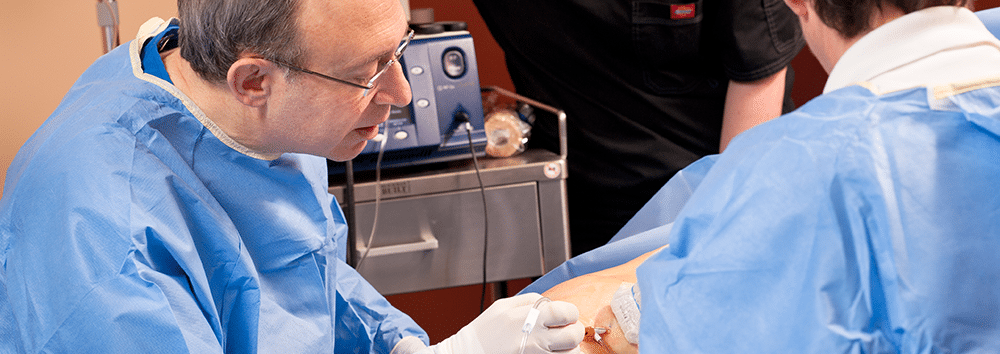WHAT ARE SPIDER AND VARICOSE VEINS?
Varicose veins are large, dilated, bulging veins that can affect individuals, both male and female, at some point during their lives. Typical symptoms include heaviness, itching, aching, swelling, throbbing, burning and fatigue. They may also cause restless legs and leg cramping. Spider veins, or telangiectasias, are smaller varicose veins. They are unsightly and may itch or bleed.
WHAT CAUSES SPIDER AND VARICOSE VEINS?
Many people have inherited a weakness in the walls of the veins of their legs. About half of the people with varicose veins have a relative with the same problem. With time the veins become dilated, distended and painful. With dilatation of the veins, some of the vein structures, called valves, malfunction and do not help blood to return to the heart from the legs. Due to the effects of gravity, the blood pools in the lower legs and causes further widening of the veins. In addition to causing discomfort or pain, the leaking creates internal pressure on the skin which can lead to swelling, redness, skin discoloration, pain and even formation of skin ulcers. The risk of developing varicose veins can also increase with increasing age, hormonal changes (puberty, pregnancy and menopause), oral hormone (for example, birth control pills) use. During pregnancy the veins enlarge due to the significant increase in the volume of blood in the body. Additionally, the growing uterus places pressure on the veins of the abdomen and pelvis and impedes return of blood to the heart.
WHAT ARE THE SYMPTOMS OF SPIDER AND VARICOSE VEINS?
As stated above, there are a variety of symptoms including leg pain, throbbing, heaviness, itching, burning, discoloration, ulceration, fatigue, restless leg syndrome and cramping. Spider and varicose veins are aesthetically unpleasing to some people who may become upset and aggravated about this condition.
CAN I PREVENT SPIDER AND VARICOSE VEINS?
While the tendency to develop varicose veins is inherited, one can take steps to slow the development and appearance of varicose veins. Weight loss and exercise both help facilitate return of blood to the heart and reduce pressure in the veins. Obesity leads to abdominal fat, which places pressure on the large veins in the pelvis and abdomen, thereby causing blood to back up into the legs. This increases the pressure in the veins and can hasten the development of varicosities and symptoms. Exercise causes the calf muscles, which serve as a blood pump, to pump blood towards the heart, thereby reducing the blood congestion and pressure in the leg veins. If one must stand on one’s legs for extended periods of time, the use of compression stockings may also reduce symptoms and slow the progression of the vein enlargement.
WHAT HAPPENS IF SPIDER AND VARICOSE VEINS GO UNTREATED?
If left untreated, the veins may go on to cause increasing degrees of pressure on the skin in their vicinity. This can lead to swelling, skin irritation, blister formation and, in the worst case, breakdown of the skin with development of ulcerations. Interruption of the integrity of the skin can serve as an entry point for bacteria that can then lead to skin infections called cellulitis. The larger the veins get the more they bulge and the more unsightly they become.
Dr. Klein encourages you to schedule a free consultative appointment with his Plano, TX vein specialist office to determine the severity of your varicose veins and possible treatments.
VARICOSE VEIN TREATMENT OPTIONS IN PLANO, TX
Dr. Mordecai Klein provides and is skilled in procedures that give varicose vein pain relief. These include:
- VENEFIT tm- placement of a radiofrequency (RF) catheter into the affected vein which then heats the vein from the inside, leading to its shrinkage and ultimate closure by scarring.
- SCLEROTHERAPY/FOAM SCLEROTHERAPY- injection of a detergent/irritant into the vein which causes the vein to become inflamed and to close by scarring. This can be done with ultrasound guidance when the veins are large, leaking and not easily visible to the eye on the surface of the skin.
- AMBULATORY PHLEBECTOMY or MICROPHLEBECTOMY- physically grabbing the vein and removing it through a series of very small incisions that heal with little or no scarring.
- COMPRESSION STOCKINGS-stockings, some even somewhat stylish, that contain elastic that exerts pressure on the veins so they cannot swell. The stockings also have graduated pressures that help move the blood from the feet to the heart. Graduated means that the pressure exerted is greatest at the foot/ankle and diminishes at the portions of stockings higher on the leg.
These treatments may be used alone or frequently in combination. They will relieve pain and heaviness. They will also lead to healing of ulcerations, if they are present. The visual appearance of the legs, in most cases, will also markedly improve.
WILL INSURANCE PAY FOR SPIDER AND VARICOSE VEIN TREATMENTS?
Criteria for coverage vary between insurers. In most cases, symptomatic varicose veins that interfere with daily activities are covered. Please contact our office for more information. We will be happy to review the whole process with you and let you know what to expect with respect to cost before the day of your procedure.
Again, insurance companies all approach vein claims differently; we will do our best to help make the costs to you transparent.
IS THERE AN ADVANTAGE TO HAVING A CARDIOLOGIST FIX MY VEINS?
While many types of doctors are starting to treat veins there are a few advantages of going to an Interventional Cardiologist:
- An interventional cardiologist has many more years of experience placing catheters in arteries and veins than other physicians performing vein treatments.
- The manual dexterity and skills are already well developed and ready to help treat your vein issues.
- Call our office to schedule a FREE initial screening visit.

